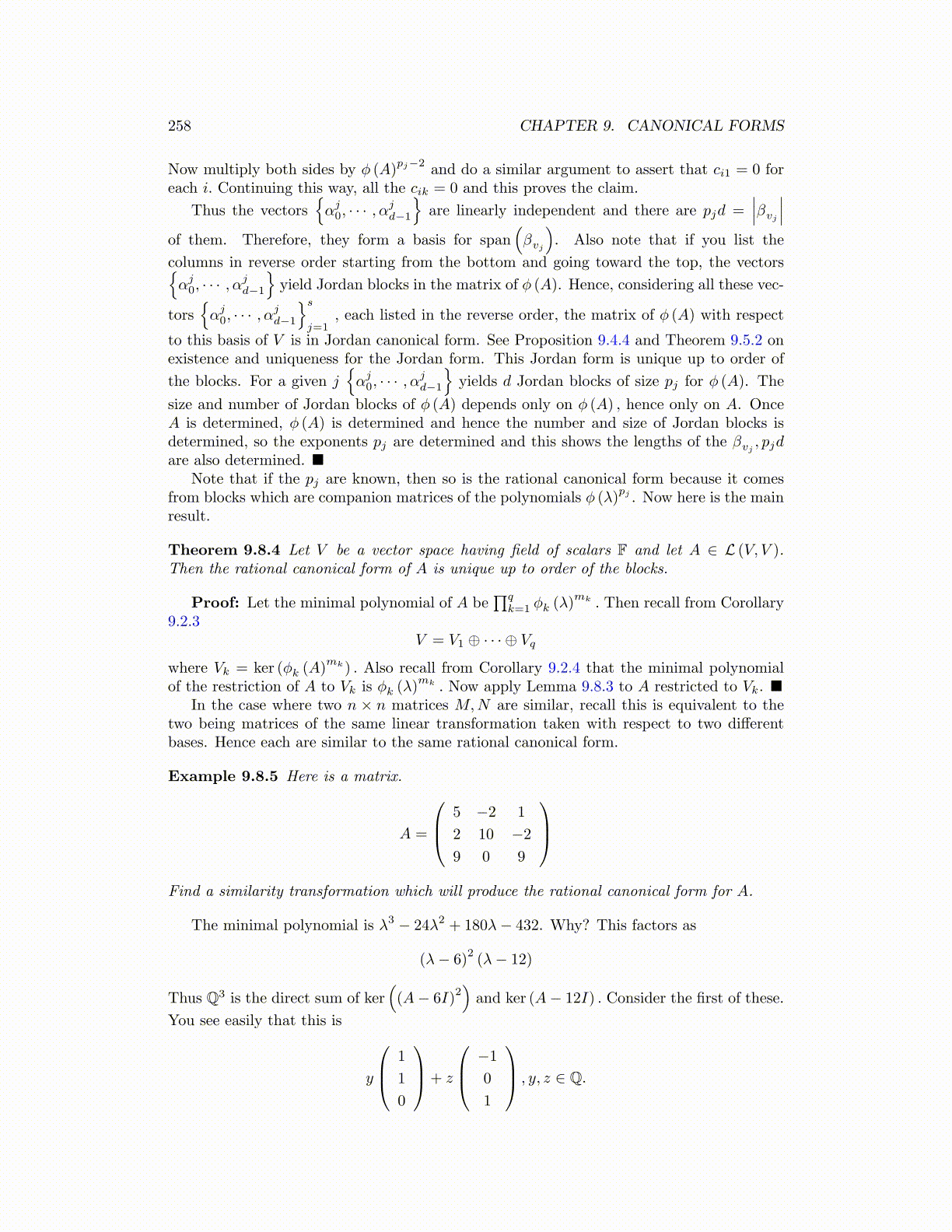
258 CHAPTER 9. CANONICAL FORMS
Now multiply both sides by ϕ (A)pj−2
and do a similar argument to assert that ci1 = 0 foreach i. Continuing this way, all the cik = 0 and this proves the claim.
Thus the vectors{αj0, · · · , α
jd−1
}are linearly independent and there are pjd =
∣∣∣βvj
∣∣∣of them. Therefore, they form a basis for span
(βvj
). Also note that if you list the
columns in reverse order starting from the bottom and going toward the top, the vectors{αj0, · · · , α
jd−1
}yield Jordan blocks in the matrix of ϕ (A). Hence, considering all these vec-
tors{αj0, · · · , α
jd−1
}s
j=1, each listed in the reverse order, the matrix of ϕ (A) with respect
to this basis of V is in Jordan canonical form. See Proposition 9.4.4 and Theorem 9.5.2 onexistence and uniqueness for the Jordan form. This Jordan form is unique up to order of
the blocks. For a given j{αj0, · · · , α
jd−1
}yields d Jordan blocks of size pj for ϕ (A). The
size and number of Jordan blocks of ϕ (A) depends only on ϕ (A) , hence only on A. OnceA is determined, ϕ (A) is determined and hence the number and size of Jordan blocks isdetermined, so the exponents pj are determined and this shows the lengths of the βvj , pjdare also determined. ■
Note that if the pj are known, then so is the rational canonical form because it comesfrom blocks which are companion matrices of the polynomials ϕ (λ)
pj . Now here is the mainresult.
Theorem 9.8.4 Let V be a vector space having field of scalars F and let A ∈ L (V, V ).Then the rational canonical form of A is unique up to order of the blocks.
Proof: Let the minimal polynomial of A be∏q
k=1 ϕk (λ)mk . Then recall from Corollary
9.2.3V = V1 ⊕ · · · ⊕ Vq
where Vk = ker (ϕk (A)mk) . Also recall from Corollary 9.2.4 that the minimal polynomial
of the restriction of A to Vk is ϕk (λ)mk . Now apply Lemma 9.8.3 to A restricted to Vk. ■
In the case where two n × n matrices M,N are similar, recall this is equivalent to thetwo being matrices of the same linear transformation taken with respect to two differentbases. Hence each are similar to the same rational canonical form.
Example 9.8.5 Here is a matrix.
A =
5 −2 1
2 10 −2
9 0 9
Find a similarity transformation which will produce the rational canonical form for A.
The minimal polynomial is λ3 − 24λ2 + 180λ− 432. Why? This factors as
(λ− 6)2(λ− 12)
Thus Q3 is the direct sum of ker((A− 6I)
2)and ker (A− 12I) . Consider the first of these.
You see easily that this is
y
1
1
0
+ z
−1
0
1
, y, z ∈ Q.